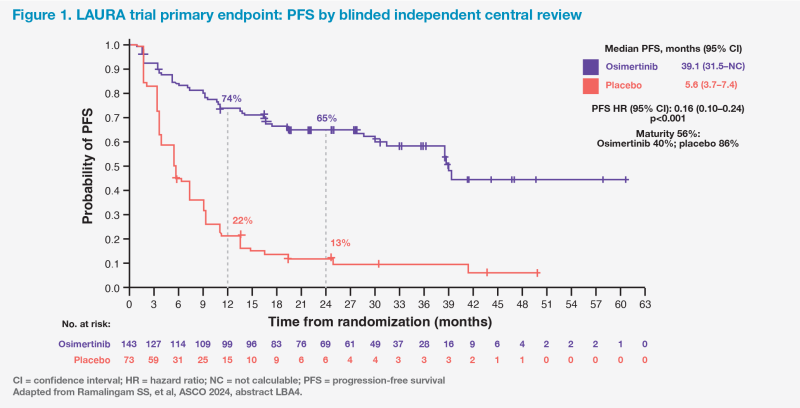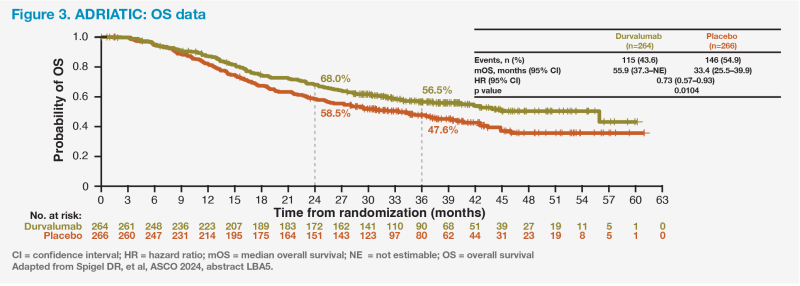Expanding the paradigm of consolidation therapy in NSCLC and SCLC





Concurrent chemoradiotherapy (cCRT) has long been the standard curative-intent treatment for stage III unresectable non-small-cell lung cancer (NSCLC) and limited-stage (LS) small-cell lung cancer (SCLC). Following cCRT, consolidation therapy with durvalumab, an anti–PD-L1 antibody, is considered the standard-of-care (SoC) for patients with stage III NSCLC with no actionable genomic alterations. However, uncertainty exists on consolidation therapy options with EGFR tyrosine kinase inhibitors (TKIs) for patients with EGFR-mutant NSCLC, given the established evidence supporting their use in both resectable and unresectable stages, as well as in LS-SCLC. At an industry-sponsored symposium, Professor Te- Chun Hsia of the China Medical University Hospital in Taichung, Taiwan, discussed evolving consolidation therapy strategies in lung cancer, highlighting the role of osimertinib, a third-generation EGFR TKI, in patients with unresectable stage III EGFR-mutated NSCLC, and durvalumab in those with LS-SCLC.
Historical landscape of consolidation therapy
“cCRT has been the foundation for curative-intent treatment in patients with unresectable stage III NSCLC and LSSCLC,” noted Hsia.
The phase III PACIFIC trial demonstrated that adding 1 year of consolidation therapy with durvalumab after cCRT significantly improved progression-free survival (PFS; hazard ratio [HR], 0.52; 95 percent confidence interval [CI], 0.42– 0.65; p<0.001) and overall survival (OS; HR, 0.68; 99.73 percent CI, 0.47–0.997; p=0.0025) vs placebo in patients with locally advanced, unresectable, stage III NSCLC. [N Engl J Med 2017;377:1919- 1929; N Engl J Med 2018;379:2342- 2350]
“Results of PACIFIC were practice-changing, with durvalumab becoming the global SoC consolidation therapy in this patient group since 2018,” he noted. “However, in patients with EGFR-mutant NSCLC, durvalumab was not associated with a clear survival benefit vs placebo.”
Although sample size was limited, post hoc subgroup analysis of PACIFIC showed that PFS and OS outcomes with durvalumab were similar to placebo for patients with EGFR-positive tumours, with wide CIs. After a median follow-up of 42.7 months, the median PFS (mPFS) was 11.2 months with durvalumab vs 10.9 months with placebo (HR, 0.91; 95 percent CI, 0.39–2.13), while median OS was 46.8 vs 43.0 months (HR, 1.02; 95 percent CI, 0.39–2.63) among patients with EGFR-positive NSCLC. [J Thorac Oncol 2023;18:657-663]
“At the same time, no approved consolidation approaches existed for patients with LS-SCLC, with relapse rates and long-term survival remaining poor despite cCRT optimizations,” noted Hsia. [N Engl J Med 2024;391:1313-1327]
LAURA: Osimertinib after cCRT for stage III EGFRmutated NSCLC
“The phase III, double-blind, placebocontrolled LAURA trial of osimertinib is a major advance for consolidation thera py in patients with unresectable stage III EGFR-mutated NSCLC,” said Hsia. [Ramalingam SS, et al, ASCO 2024, abstract LBA4; N Engl J Med 2024;391:585-597]
LAURA included 216 patients with unresectable EGFR-mutated (ie, exon 19 or L858R deletion) stage III NSCLC without progression during or after cCRT. They were randomized 2:1 to receive either osimertinib 80 mg/day or placebo. Treatment continued until disease progression or regimen discontinuation.
Osimertinib demonstrated a significant PFS benefit vs placebo, with mPFS of 39.1 vs 5.6 months, representing an 84 percent reduction in risk of progression or death (HR, 0.16; 95 percent CI, 0.10–0.24; p<0.001). (Figure 1)

The PFS Kaplan–Meier curves showed early separation between treatment groups, which was sustained throughout follow-up. At 12 and 24 months, the PFS rates were 74 and 65 percent with osimertinib vs 22 and 13 percent with placebo, respectively. (Figure 1) [N Engl J Med 2024;391:585-597]
“Importantly, osimertinib was associated with fewer new brain lesions than placebo [8 vs 29 percent], highlighting marked central nervous system [CNS] protection,” added Hsia.
PFS benefit was consistent across all subgroups, including sex, age, performance status, EGFR mutation, race, and chemoradiotherapy type. No new safety signals emerged. Rates of grade ≥3 adverse events (AEs) were modest (35 percent for osimertinib vs 12 percent for placebo), with most radiation pneumonitis events being mild or moderate.
A representative case from LAURA — a 65-year-old male with unresectable stage III EGFR-mutant NSCLC — highlights the durable long-term control and manageable toxicity associated with osimertinib consolidation after cCRT. (Case study)

In parallel, the multinational KINDLE observational study offers valuable real-world insights into treatment strategies for stage III NSCLC, including patients with unresectable EGFR-mutant disease. In the Taiwan subgroup (n=200), outcomes among patients receiving upfront EGFR TKI alone (group 2) were inferior to those receiving upfront cCRT followed by sequential EGFR TKI upon progression (group 3). Specifically, group 3 had markedly longer median time to second disease progression (mPFS2; 46.3 vs 15.2 months; p=0.022) and median OS (mOS; 49.0 vs 27.4 months; p=0.03). These findings reinforce superior survival outcomes with initial cCRT followed by sequential EGFR TKI vs upfront EGFR TKI in patients with unresectable EGFRmutant stage III NSCLC, supporting the strategy now validated in LAURA. [JTO Clin Res Rep 2022;3:100292; N Engl J Med 2024;391:585-597]
ADRIATIC: Durvalumab consolidation for LS-SCLC
“SCLC remains an aggressive disease with poor long-term survival, with no major breakthroughs in treatment after cCRT for decades,” noted Hsia. [N Engl J Med 2024;391:1313-1327] “In Taiwan, SCLC is considered the most aggressive type of lung cancer, with approximately 80 percent of patients estimated to have extensive-stage disease at diagnosis.” [Int J Mol Sci 2022;23:7037]
About one-third of SCLC cases present with LS disease, where SoC cCRT is often followed by prophylactic cranial irradiation. Despite this intensive approach, relapse rates are high, with most patients experiencing recurrence within 2 years, and 5-year OS rate remains poor at 29–34 percent. [N Engl J Med 2024;391:1313-1327]
The phase III, double-blind, randomized, placebo-controlled ADRIATIC trial provides the first robust OS and PFS breakthroughs for consolidation therapy in LS-SCLC. The study included patients with LS-SCLC who did not have disease progression after cCRT. The patients received either intravenous durvalumab (1,500 mg; n=264), durvalumab (1,500 mg) plus tremelimumab (75 mg, four doses only) (n=200), or placebo (n=266) Q4W for up to 24 months.
Durvalumab consolidation significantly extended OS for more than 22 months. mOS with durvalumab vs placebo was 55.9 vs 33.4 months (HR, 0.73; 95 percent CI, 0.57–0.93; p=0.0104). (Figure 3) Similarly, PFS was markedly improved with durvalumab, with mPFS of 16.6 vs 9.2 months with placebo (HR, 0.76; 95 percent CI, 0.61–0.95; p=0.0161). (Figure 4) [Spigel DR, et al, ASCO 2024, abstract LBA5]


Durvalumab was well tolerated and had comparable safety to placebo. Grade 3–4 AE rates were 24.4 vs 24.2 percent, and serious AE rates were 29.8 vs 24.2 percent. Pneumonitis (any grade) was common, but severe events were rare (3.1 vs 2.6 percent). Treatment discontinuation due to AEs occurred in 16.4 vs 10.6 percent of patients in the durvalumab vs placebo group, and were typically due to pneumonitis or radiation pneumonitis.
“These robust efficacy and safety data establish durvalumab as a transformative option for consolidation therapy in patients with LS-SCLC. It is expected to become a new SoC consolidation therapy in this population,” noted Hsia.
Changing the treatment landscape: Personalized consolidation
“The paradigm for consolidation therapy in patients with unresectable stage III NSCLC and LS-SCLC is shifting toward a personalized, biomarkerdriven approach,” said Hsia. [Int J Mol Sci 2022;23:7037]
While durvalumab consolidation remains the SoC for unresectable stage III NSCLC without actionable oncogenic drivers, results from ADRIATIC support its role as a new SoC for post-cCRT LS-SCLC. [N Engl J Med 2018;379:2342-2350; N Engl J Med 2024;391:1313-1327]
“For patients with unresectable EGFR-mutant stage III NSCLC, consolidation with osimertinib after cCRT delivers unprecedented improvements in PFS and CNS protection, fundamentally changing practice for this population,” Hsia added. [N Engl J Med 2024;391:585-597]
“The future of consolidation therapy will be increasingly guided by histology, key molecular biomarkers, and multidisciplinary decision-making,” he said. “These developments highlight the need for routine EGFR testing in stage III NSCLC and underscore the advent of genotype- and histology-specific consolidation strategies in thoracic oncology.” [Int J Mol Sci 2022;23:7037]
Summary
“We are now entering a phase where the consolidation approach is no longer ‘one-size-fits-all’ but customized based on each patient’s tumour biology and disease characteristics,” noted Hsia. Pivotal advances from the LAURA and ADRIATIC trials define a new era of individualized consolidation therapy, rooted in molecular and histological profiling. Selecting consolidation agents such as durvalumab or osimertinib according to individual tumour features ensures patients receive the most durable therapeutic benefit.